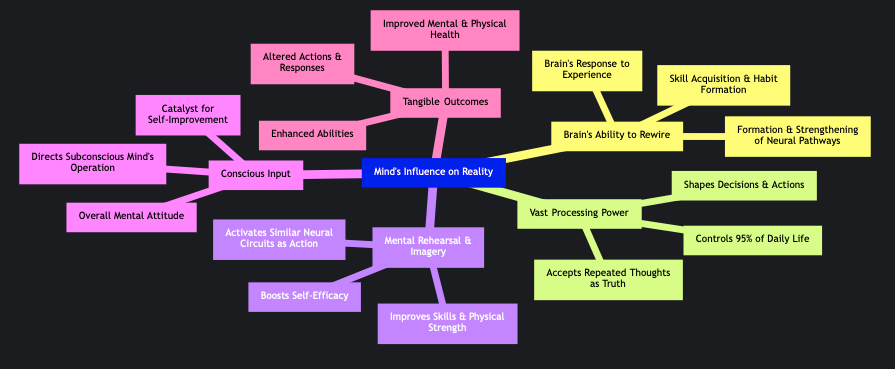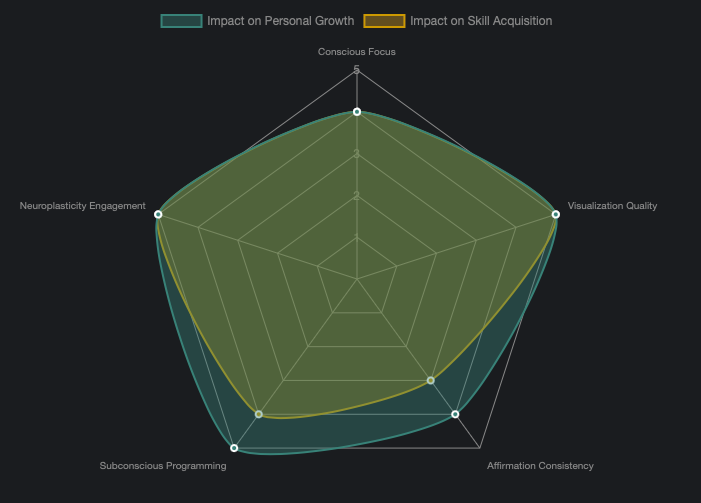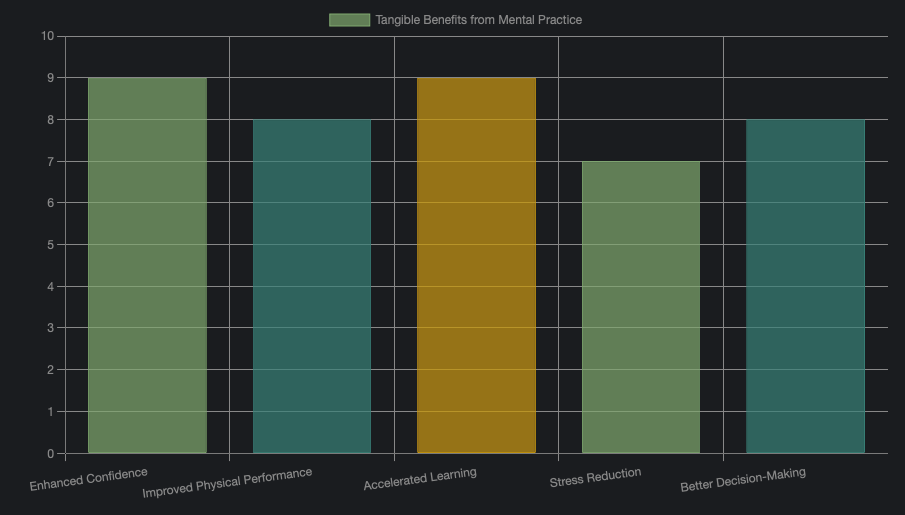Explore the profound synergy between thought, neuroscience, and personal transformation, revealing the scientific basis of “mind over matter.”
77+ Sources
- Key Insights into the Mind’s Transformative Power
- The Brain’s Dynamic Nature: Embracing Neuroplasticity
- The Silent Architect: Understanding the Subconscious Mind
- Visualization: Bridging the Gap Between Thought and Action
- Applying Scientific Principles for Personal Transformation
- Mapping the Mind’s Influence on Reality
- Quantifying Mental Impact: A Comparative Analysis
- Summary of Mental Mechanisms and Their Outcomes
- Frequently Asked Questions
- Conclusion: Your Mind as Your Most Powerful Tool
- Recommended Further Exploration
- Referenced Search Results
The idea that your thoughts can profoundly influence and even physically alter your reality, a concept often attributed to philosophical or self-help teachings, is increasingly supported by modern neuroscience. Far from being magical thinking, this phenomenon is deeply rooted in the brain’s remarkable capacity for adaptation and the profound influence of the subconscious mind. This convergence of long-held beliefs, championed by figures like Dr. Joseph Murphy, and contemporary scientific discovery, highlights how intentional mental activity serves as a powerful tool for personal growth and shaping the life you desire.
Key Insights into the Mind’s Transformative Power
- Neuroplasticity is Your Brain’s Superpower: Your brain isn’t static; it constantly reorganizes and rewires itself in response to your experiences, learning, and critically, your focused thoughts. This ability, known as neuroplasticity, is the biological foundation for how mental effort can lead to tangible changes.
- Visualization: Mental Rehearsal with Real-World Impact: Vividly imagining an action or outcome activates similar neural pathways as performing the actual task. This “mental practice” can enhance physical performance, skill acquisition, and even muscle strength, demonstrating a direct link between thought and physical manifestation.
- The Subconscious Mind: A Vast, Programmable Engine: Operating largely below conscious awareness, the subconscious processes an immense amount of information and influences up to 95% of daily activities. By consistently feeding it positive or success-oriented thoughts, you effectively “program” it to align your behaviors and perceptions with your desired reality.
The Brain’s Dynamic Nature: Embracing Neuroplasticity
At the heart of the mind’s ability to shape reality is the concept of neuroplasticity. This groundbreaking understanding in neuroscience has overturned older beliefs that the adult brain was fixed and unchangeable. Instead, we now know the brain is incredibly dynamic, capable of forming new neural connections and strengthening existing ones throughout life. Every thought, every experience, and every action contributes to this ongoing rewiring process.

Neural pathways in the brain, illustrating the complex network that can be reorganized through neuroplasticity.
How Thought Fuels Brain Rewiring
When you engage in focused thought, whether through learning a new skill, practicing visualization, or affirming a belief, you are actively participating in neuroplasticity. This mental engagement strengthens specific neural pathways associated with those thoughts and actions. Repeated mental input, much like physical repetition, leads to more robust and efficient neural networks. This means that consistent mental focus can physically alter the brain’s structure and function, impacting everything from cognitive abilities to emotional responses.
For instance, brain scans reveal that areas of the brain involved in motor control light up when an individual merely imagines performing a physical action. This mirroring of neural activity underscores how powerfully mental states can influence physical processes without direct physical engagement. The implication is profound: by consciously directing your thoughts, you are, in essence, sculpting your brain.
The Silent Architect: Understanding the Subconscious Mind
Dr. Joseph Murphy’s teachings emphasized the subconscious mind as a powerful, receptive force that accepts whatever is impressed upon it, regardless of whether it’s beneficial or detrimental. Modern neuroscience supports the immense influence of the subconscious, though it frames it in terms of unconscious and implicit processes rather than a literal “computer” module. The subconscious mind operates far beyond our conscious awareness, processing vast amounts of information—estimated to be millions of bits per second compared to the conscious mind’s mere forty bits. This vast processing power means that the subconscious significantly influences our thoughts, emotions, habits, and ultimately, our decisions and actions.
Programming Your Inner Computer
The metaphor of “programming” your subconscious mind with your daily thoughts is scientifically apt. By consistently focusing on specific thoughts, affirmations, or visualizations, you are feeding the subconscious mind information it integrates into its operational framework. This constant input, whether it’s focused on success or failure, shapes your unconscious biases, automatic responses, and even physiological reactions. Brain imaging studies have shown that the brain uses similar neural circuits for unconscious actions as it does for conscious ones, highlighting the pervasive influence of processes operating below our awareness.
This powerful interplay means that your mindset isn’t just a fleeting feeling; it’s a persistent force that molds your internal landscape. By consciously choosing what to focus on and what beliefs to entertain, you can strategically “reprogram” your subconscious to align with your goals, foster positive habits, and reduce self-limiting beliefs.
Visualization: Bridging the Gap Between Thought and Action
Visualization is a powerful cognitive tool that leverages the brain’s neuroplasticity and the subconscious mind to create tangible real-world outcomes. It’s more than just daydreaming; it’s a targeted mental rehearsal that engages the same neural pathways as if you were physically performing an action. This explains why mental practice can be so effective in improving performance and skill acquisition across various domains.
Evidenced-Based Impact of Visualization
Numerous studies highlight the efficacy of visualization:
- Piano Practice: Research has demonstrated that individuals who mentally rehearse playing the piano show similar brain changes and improvements in motor skills as those who physically practice. This indicates that mental simulation can strengthen neural connections in a way comparable to actual physical training.

Mental practice of piano playing can lead to similar brain changes as physical practice.
- Muscle Strength: Studies have shown that simply imagining exercise can lead to measurable increases in muscle strength. This “mind over matter” effect occurs because visualization enhances neural drive and motor unit recruitment, optimizing the brain’s ability to activate muscles. While it doesn’t lead to muscle hypertrophy, it significantly improves the brain-to-muscle connection.
- Skill Development and Performance: Athletes, musicians, and even patients in rehabilitation use guided imagery to improve performance, enhance confidence, and accelerate recovery. By vividly imagining success and overcoming obstacles, they strengthen the neural pathways required for optimal execution, reducing anxiety and bolstering self-efficacy.
The Mechanics of Mental Imagery
When you visualize, your brain doesn’t fully distinguish between a real experience and a vividly imagined one. This phenomenon activates similar neural networks in areas responsible for perception, emotion, and motor control. The occipital lobe, crucial for visual processing, is particularly active during visualization. By consistently engaging in this mental rehearsal, you are, in essence, building and reinforcing neural blueprints for your desired actions and outcomes. This continuous process of mental rehearsal contributes to improved confidence and effectiveness in achieving goals.
This video discusses the scientific benefits of visualization, particularly in athletic performance, explaining how mental rehearsal can significantly impact physical capabilities by engaging the brain’s neural pathways.
Applying Scientific Principles for Personal Transformation
Harnessing the power of your thoughts requires a strategic and consistent approach, integrating the scientific principles of neuroplasticity, subconscious influence, and visualization. It’s about treating your mind as a trainable asset, much like a muscle that strengthens with specific, repeated exercise.
Strategic Visualization and Affirmation
To effectively leverage your mind’s capacity for change, consider these strategies:
- Define Precise Goals: Clearly articulate what you want to achieve. Vague intentions lead to vague results. Translate your outcomes into process-oriented scripts that you can visualize in detail.
- Engage Multiple Senses: When visualizing, don’t just “see” the outcome. Try to “feel” the emotions associated with success, “hear” the sounds of your achievement, and even “smell” or “taste” elements of your desired reality. This multi-sensory engagement makes the visualization more vivid and impactful.
- Consistent Practice: Short, frequent sessions (e.g., 5-10 minutes, 1-3 times daily) are often more effective than long, infrequent ones. Consistency reinforces neural pathways.
- Combine with Action: While powerful, mental practice augments, it doesn’t replace physical action. The most durable changes occur when high-quality physical practice is combined with specific mental rehearsal, feedback, and spaced repetition.
- Rehearse Obstacles and Recovery: Instead of only visualizing perfect scenarios, briefly visualize potential obstacles and then vividly rehearse your successful recovery or adaptation. This builds resilience and robust control policies.
The Synergy of Mind and Brain for Success
The mind’s power to shape reality is not a passive process. It’s an active, ongoing interaction between your conscious thoughts, your subconscious programming, and the adaptive nature of your brain. By understanding these mechanisms, you gain control over a powerful tool for personal transformation. The convergence of Dr. Joseph Murphy’s timeless wisdom and contemporary neuroscience provides a compelling framework for taking charge of your internal landscape and, by extension, your external reality.
Mapping the Mind’s Influence on Reality
This mindmap illustrates the interconnected components through which your thoughts and mindset influence your reality, emphasizing the central role of neuroplasticity and the subconscious mind.
mindmap
root[“Mind’s Influence on Reality”]
Neuroplasticity[“Brain’s Ability to Rewire”]
Neural_Pathways[“Formation & Strengthening of Neural Pathways”]
Learning[“Skill Acquisition & Habit Formation”]
Adaptation[“Brain’s Response to Experience”]
Subconscious_Mind[“Vast Processing Power”]
Automatic_Functions[“Controls 95% of Daily Life”]
Belief_Systems[“Accepts Repeated Thoughts as Truth”]
Influence_on_Behavior[“Shapes Decisions & Actions”]
Visualization[“Mental Rehearsal & Imagery”]
Neural_Activation[“Activates Similar Neural Circuits as Action”]
Performance_Enhancement[“Improves Skills & Physical Strength”]
Confidence_Building[“Boosts Self-Efficacy”]
Thoughts_Affirmations_Focus[“Conscious Input”]
Programming[“Directs Subconscious Mind’s Operation”]
Mindset[“Overall Mental Attitude”]
Personal_Growth[“Catalyst for Self-Improvement”]
Physical_Reality[“Tangible Outcomes”]
Behavioral_Changes[“Altered Actions & Responses”]
Skill_Improvements[“Enhanced Abilities”]
Well_being[“Improved Mental & Physical Health”]

Quantifying Mental Impact: A Comparative Analysis
To further illustrate the profound impact of mental processes, let’s look at how different mental factors contribute to overall life enhancement. These charts represent an opinionated analysis of the relative contribution of various mental tools based on the principles discussed.

This radar chart illustrates the perceived impact of various mental components on personal growth and skill acquisition, on a scale of 0 to 5, reflecting how deeply each factor contributes to positive change.

This bar chart illustrates the magnitude of various tangible benefits derived from consistent mental practice, rated on a scale of 0 to 10.
Summary of Mental Mechanisms and Their Outcomes
The table below summarizes the key mental mechanisms discussed and their primary outcomes, illustrating how each component contributes to shaping your reality.
| Mental Mechanism | Core Function | Primary Outcome | Scientific Basis |
|---|---|---|---|
| Conscious Thought & Focus | Directing attention; deliberate belief formation | Intentional programming of the subconscious; shaping mindset | Cognitive neuroscience, attention studies |
| Subconscious Mind | Automatic processing; habit formation; emotional regulation | Foundation for beliefs and reactions; drives 95% of daily life | Neuroscience of implicit processes; behavioral psychology |
| Neuroplasticity | Brain’s ability to reorganize and adapt | Physical rewiring of neural pathways; brain changes in response to experience | Brain imaging studies, synaptic plasticity research |
| Visualization & Mental Imagery | Simulating experiences mentally; vivid mental rehearsal | Enhanced skill acquisition; improved physical performance; boosted confidence | Motor learning research, neuroimaging of sensory-motor cortices |
| Affirmations & Repetition | Consistent positive statements; reinforcement of beliefs | Reinforcing desired mental programs; strengthening positive neural connections | Cognitive psychology, studies on habit formation |
Frequently Asked Questions
What is neuroplasticity, and how does it relate to my thoughts?
Neuroplasticity is your brain’s remarkable ability to reorganize itself by forming new neural connections or strengthening existing ones. Your thoughts, especially focused and repeated ones, stimulate this process, causing physical changes in your brain’s structure and function.
Can visualization really improve physical abilities?
Yes, numerous studies confirm that visualization can improve physical abilities. By mentally rehearsing actions, you activate similar neural pathways as if you were physically performing them, which can enhance muscle strength, coordination, and overall performance.
How does the subconscious mind affect my reality?
The subconscious mind processes vast amounts of information and influences up to 95% of your daily behaviors and decisions. It acts upon the beliefs and thoughts it is consistently fed, shaping your perceptions, reactions, and ultimately, your experienced reality.
Is the “mind over matter” concept truly scientific?
While “mind over matter” might sound unscientific, neuroscience provides a clear basis for it. Mental focus, visualization, and positive beliefs can trigger neuroplastic changes that affect physical and psychological outcomes, demonstrating a tangible connection between mental states and physical realities.
What is the role of affirmations in changing my reality?
Affirmations are positive statements repeated consistently. Their role is to impress desired beliefs onto your subconscious mind, reinforcing positive neural pathways and aligning your internal programming with your goals, which can lead to behavioral changes and desired outcomes.
Conclusion: Your Mind as Your Most Powerful Tool
The synergy between historical wisdom and cutting-edge neuroscience reveals a profound truth: your thoughts are not merely fleeting mental events but active forces shaping your internal and external worlds. The brain’s incredible capacity for neuroplasticity, coupled with the vast, influential power of the subconscious mind, means that focused intention, visualization, and consistent mental practice can indeed lead to tangible changes in your skills, performance, and overall well-being. By embracing these scientific principles, you can consciously direct your mental energy to “program” your reality, transforming abstract desires into lived experiences. This understanding empowers you to harness your mindset as the most potent tool for personal growth and for actively constructing the life you envision.
Recommended Further Exploration
- How can neuroplasticity be practically applied in daily life for self-improvement?
- What are the latest scientific studies on visualization and athletic performance?
- What are effective, science-backed methods to reprogram the subconscious mind?
- How does the mind-body connection influence physical healing and well-being?
Referenced Search Results
sciencedirect.com
physio-pedia.com
Doidge, N. The Brain That Changes Itself (2007) – Physio-pedia
voiceinsport.com
The Science Behind VISualization: What Happens In The Brain? – Voice In Sport
npjscilearncommunity.nature.com
Visualisation – It’s like weight-lifting for the brain – Neuroscience Community
rowancenterla.com
The Power of Visualization: Unlock Your Mind’s Potential – Rowan Center LA
verywellmind.com
Neuroplasticity: How Experience Changes the Brain – Verywell Mind
researchgate.net
(PDF) The Power of the Subconscious Mind – ResearchGate
linkedin.com
ww1.dr-joseph-murphy.com
stroke.org.uk
Neuroplasticity: re-wiring the brain | Stroke Association
imahealth.org
Brain Health – Independent Medical Alliance
medium.com
60 Years On: Joseph Murphy’s “The Power of Your …
nicabm.com
How Does Neuroplasticity Work? [Infographic] – NICABM
gailmarrahypnotherapy.com
9 interesting facts about your subconscious mind – Gail Marra …
divinescienceministersassociation.org
quora.com
Is there any scientific evidence that the subconscious mind …
reddit.com
r/askpsychology on Reddit: What is the best hard evidence that …
web.iitd.ac.in
THE POWER OF YOUR SUBCONCIOUS MIND
faculty.washington.edu
Neuroscience for Kids – Brain Plasticity
lidsen.com
Neuroprotection, Neuroregeneration and Neuroplasticity
psychologytoday.com
Brain Basics, Part One: The Power of Visualization – Psychology Today
melrobbins.com
Focus Better: Tips from a Brain Expert – Mel Robbins
pmc.ncbi.nlm.nih.gov
Visualizing risky situations induces a stronger neural response in …
theswaddle.com
Dating Like a Savarna | The Swaddle
mcpress.mayoclinic.org
The power of neuroplasticity: How your brain adapts and grows as you age – Mayo Clinic Press
nytimes.com
The Subconscious Brain – Who’s Minding the Mind? – The New York Times
edutopia.org
Neuroplasticity: Learning Physically Changes the Brain | Edutopia
en.wikipedia.org
en.wikipedia.org
god-helmet.com
About Us – Spirituality and the Brain
neuroskills.com
Neuroplasticity | Centre for Neuro Skills
psychologytoday.com
Neuroplasticity | Psychology Today
psychologytoday.com
Brain Basics, Part One: The Power of Visualization | Psychology Today
pmc.ncbi.nlm.nih.gov
Visualizing the mind’s eye: a future perspective on applications of …
penguinrandomhouse.com
markspsychiatry.com
Neuroplasticity Explained: How to Rewire Your Brain for Mental Strength
ncbi.nlm.nih.gov
Neuroplasticity – StatPearls – NCBI Bookshelf
dailynews.mcmaster.ca
Lessons from the National Indigenous History Month and Pride Month launch event – Daily News
futurelearn.com
pmc.ncbi.nlm.nih.gov
Exploring the Role of Neuroplasticity in Development, Aging, and Neurodegeneration – PMC
webmd.com
Neuroplasticity: What It Is and How It Works
sundayindependent.co.za
The Subconscious Revealed: Navigating Joseph Murphy’s …
solportal.ibe-unesco.org
IBE — Science of learning portal — Neuroplasticity: How the brain changes with learning
spreaker.com
The Advisor with Stacey Chillemi: Mindset & Self-Improvement
en.wikipedia.org
neurovine.ai
The Science of Visualization – Neurovine
ncbi.nlm.nih.gov
brainfutures.org
NEUROPLASTICITY 101 – BrainFutures
imotions.com
What Is The Subconscious Mind?
imotions.com
What Is The Subconscious Mind? – iMotions
oahu.narpm.org
The Power Of Your Subconscious Mind By Dr Joseph Murphy
universityaffairs.ca
Five top writing tips explained – University Affairs
laurentianuniversity.academia.edu
Todd Murphy – Profile on Academia.edu
health.clevelandclinic.org
What Is Neuroplasticity? How It Works
vogue.com
Doctors Agree This Is the Best Habit to Fight Brain Aging | Vogue
en.wikipedia.org
verywellmind.com
There’s a Reason Some People Can Visualize Better Than Others …
en.wikipedia.org
bethkendall.com
Why Your Subconscious Mind is Ridiculously Powerful
thereader.mitpress.mit.edu
What the Science Actually Says About Unconscious …
en.wikipedia.org
amazon.com
Neuroplasticity Explained: 9798337635057: Medicine & Health Science Books @ Amazon.com
amazon.com
Joseph Murphy – Psychology & Counseling / Health …
riversidesportstherapy.com
The Role of Visualization in Recovery and Performance
betterhelp.com
Positive Visualization: The Scientific Benefits Of Visualization
sciencedirect.com
The neuroplastic brain: current breakthroughs and emerging frontiers
god-helmet.com
Articles on the Brain and Spirituality.
bbc.com
Neuroplasticity: How to rewire your brain – BBC
nasonline.org
audible.com
Joseph Murphy – Audio Books, Best Sellers, Author Bio
unsw.edu.au
We’re in control: new research dismantles the power of …
nickfrates.com
Visualization and Goal Achievement: Science and Best Practices
linkedin.com
bbc.com
Your subconscious is smarter than you might think
aamc.org
Enlisting the vagus nerve to help the body heal itself | AAMC
news.stanford.edu
How the human mind shapes reality – Stanford Report
positivepsychology.com
What Is Neuroplasticity? A Psychologist Explains [+14 Tools]
pmc.ncbi.nlm.nih.gov
Last updated August 29, 2025

